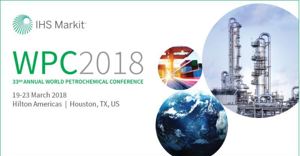WPC’18 Keynotes at World Petrochemical Conference 2018
IHS Markit’s World Petrochemical Conference 2018 was held in Houston March 21-22 with workshops and seminar sessions before and after the conference. It is their largest annual event to date, with over 1,300 registered. Wednesday featured single track Executive sessions, each concluding with a Q&A panel of the session speakers. Thursday has four breakout tracks:
• Inorganics & Derivatives
• Intermediates & Specialty Chemicals
• Olefins, Feedstocks & Derivatives
• Refining & Aromatics
The event opened with a keynote from Nariman Behravesh, Chief Economist, IHS Markit, titled “The Global Economic Outlook: How Long Can the Good Times Roll?”
His opening was an attention-getter. It used to be that politics overtook economics, but now economics is overtaking politics, apparently shrugging off the vicissitudes of the round-the-clock news cycle. The one thing that may mess up everything is a trade war: more jobs are lost than gained by a protectionism approach, such as
In the US, there have been two helpful stimuli: tax cuts and federal spending. Europe and Japan are now starting to improve, helped by
Globally, commodity prices are topping out, which reduces inflation pressures. In the US, inflation could become an issue with unemployment forecasted to reduce even lower to 3.5%.
The second keynote IHS Markit speaker was Kurt Barrow, Vice President, Oil Markets, Midstream and Downstream Insights, on “Global Crude Oil Outlook”.
His initial slide illustrated how slowly the share of energy supply sources changes. But in recent years there have been forces that may change the mix more rapidly
•
• Societal influences – emerging global middle class
• Global environmental policy and regulation forces
We have seen significant technology disruption to develop shale fields: sensors, analytics, digitalization. Much of this shale crude oil goes to Asia as
With decades of shale gas available, the US may become the world’s largest LNG exporter. Yet another disrupter is the IMO2020 regulation that is effective January 1, 2020, dropping the allowable sulfur in fuel oil from 3.5% to 0.5%. Shippers have only a few options:
• Buying lower-sulfur blended fuel oil
• LNG fuel – only seen on new vessels
• Install scrubbers: they are delaying
The immediate impact of IMO 2020 will be to the 3MMbpd heavy fuel oil market, also with an increases demand of 1MMbpd for
The final disruptor is mobility: human-operated vs driver-less cars, personally-owned vs mobility services, gasoline/diesel vs electric powertrain. One reason for drivetrain diversity is meeting fleet emission goals. This topic has its own special session, in addition to others added to the workshop days.
The future for refining growth is in refinery-petrochemical integration. Note at present one-third of the growth in petrochemical supply is from natural gas liquids. E.g. the US is the largest propane exporter and China is the largest propane importer – for petrochemicals, not fuel.








Comments